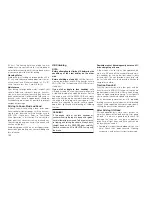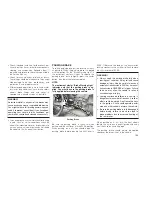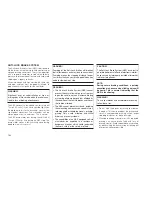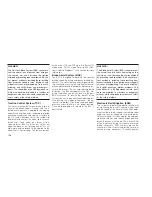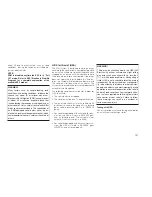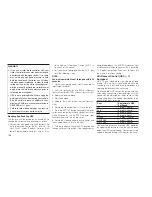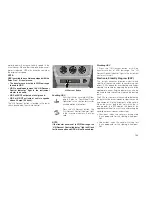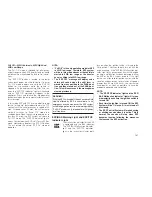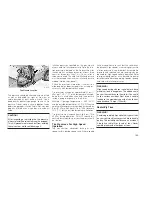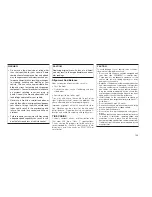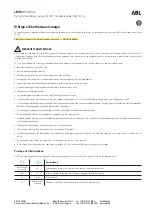
These cautions apply to all chain traction devices,
including link and cable (radial) chains.
TIRE ROTATION RECOMMENDATIONS
Tires on the front and rear axles of vehicles
operate at different loads and perform different
steering, handling, and braking functions. For
these reasons, they wear at unequal rates, and
develop irregular wear patterns.
These effects can be reduced by timely rotation of
tires. The benefits of rotation are especially worth-
while with aggressive tread designs such as those
on On/Off Road type tires. Rotation will increase
tread life, help to maintain mud, snow, and wet
traction levels, and contribute to a smooth, quiet
ride.
Follow the “Maintenance Schedule” in Section 8 of
this manual for the recommended tire rotation
frequency. Remember, more frequent rotation is
permissible if desired. Also, correct for anything
causing rapid or unusual wear prior to performing
the tire rotation.
The suggested rotation method is the “forward-
cross” shown in the following diagram.
TIRE PRESSURE MONITOR SYSTEM
(TPMS) — IF EQUIPPED
•
The Tire Pressure Monitor System (TPMS) will
warn the driver of a low tire pressure based on
the vehicle recommended cold placard pres-
sure.
•
The tire pressure will vary with temperature by
about 1 psi (6.9 kPa) for every 12°F (6.5°C).
This means that when the outside temperature
decreases, the tire pressure will decrease. Tire
pressure should always be set based on cold
inflation tire pressure. This is defined as the tire
pressure after the vehicle has not been driven
for at least three hours, or driven less than 1 mi
(1 km) after a three hour period. The cold tire
inflation pressure must not exceed the maxi-
mum inflation pressure molded into the tire
sidewall. Refer to the “Tires – General Informa-
tion” in this section for information on how to
properly inflate the vehicle’s tires. The tire pres-
sure will also increase as the vehicle is driven -
this is normal and there should be no adjust-
ment for this increased pressure.
•
The TPMS will warn the driver of a low tire
pressure if the tire pressure falls below the
low-pressure warning limit for any reason, in-
cluding low temperature effects and natural
pressure loss through the tire.
•
The TPMS will continue to warn the driver of low
tire pressure as long as the condition exists,
and will not turn off until the tire pressure is at or
above the recommended cold placard pres-
sure. Once the low tire pressure warning (Tire
Pressure Monitoring Telltale Light) illuminates,
you must increase the tire pressure to the
recommended cold placard pressure in order
for the Tire Pressure Monitoring Telltale Light to
turn off. The system will automatically update
and the Tire Pressure Monitoring Telltale Light
will turn off once the system receives the up-
dated tire pressures. The vehicle may need to
be driven for up to 10 minutes above 15 mph
(25 km/h) in order for the TPMS to receive this
information.
Tire Rotation
146
Summary of Contents for Cherokee 2009
Page 1: ......
Page 2: ......
Page 3: ......
Page 5: ...2...
Page 9: ...6...
Page 11: ...8...
Page 15: ......
Page 45: ...42...
Page 50: ...Rear Window Defroster If Equipped 89 ROOF LUGGAGE RACK IF EQUIPPED 90 47...
Page 51: ......
Page 63: ...60...
Page 64: ...61...
Page 65: ...62...
Page 97: ...INSTRUMENT CLUSTER 94...
Page 106: ...Compass Variance Map 103...
Page 111: ...Compass Variance Map 108...
Page 116: ......
Page 120: ...117...
Page 123: ...Control Setting Suggestions for Various Weather Conditions 120...
Page 147: ......
Page 159: ......
Page 162: ......
Page 175: ...172...
Page 179: ......
Page 210: ...9 IF YOU NEED CONSUMER ASSISTANCE IF YOU NEED ASSISTANCE 208 207...
Page 212: ...209...
Page 213: ...210...
Page 214: ...10 INDEX 211...

